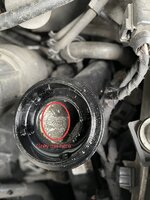You are using an out of date browser. It may not display this or other websites correctly.
You should upgrade or use an alternative browser.
You should upgrade or use an alternative browser.
So I looked in the engine bay..and then the oil filler
- Thread starter BIgben
- Start date
-
- Tags
- oil filler sludge
Jim Sherman
New Member
I found this thread but not the TSB?
Ps im a new member
Ps im a new member
Attached to post 13 So I looked in the engine bay..and then the oil fillerI found this thread but not the TSB?
Ps im a new member
Jim Sherman
New Member
Many thanks puts my mind at rest.
Mike Wedler
204motion SportLine
TPI 2043895/3 - condensed water formation on oil filler neck.
Technical product information Transaction No.: 2043895/3
Service info: condensed water formation on oil filler neck Release date: 11-Dec-2017
Customer statement / workshop findings
White paste/foam/sludge in oil filler neck.

 www.t6forum.com
www.t6forum.com
Technical product information Transaction No.: 2043895/3
Service info: condensed water formation on oil filler neck Release date: 11-Dec-2017
Customer statement / workshop findings
White paste/foam/sludge in oil filler neck.

Tpi 2043895/3 - Condensed Water Formation On Oil Filler Neck
TPI 2043895/3 - condensed water formation on oil filler neck. Technical product information Transaction No.: 2043895/3 Service info: condensed water formation on oil filler neck Release date: 11-Dec-2017 Customer statement / workshop findings White paste/foam/sludge in oil filler neck. ...
As said above...Normally never see it in the warmer months..I just clean it out every now and again...my old 406 was just the same ...these engines run quite hot and any moisture gets trapped in the plastic filler ...once You know it’s normal life goes on...but it’s good to check the other levels so nasty surprises 
Back in the olden days, the Vauxhall Viva 1256HC used to suffer from this. The cause was cold air coming through the massive engine bay over the radiator, and cooling the rocker box, causing condensation in the oil and mayo inside the rocker box and filler neck. The fix was to make up a tin deflector plate, secured by the thermostat housing bolts at the front of the head to deflect cold air around and away from the top of the motor.
That was in about 1980 though... generally most things have moved on since then.........
That was in about 1980 though... generally most things have moved on since then.........
I’ve read this thread from start to finish (again), there are a few mentions of the engine reaching 90 deg C so should be ok.
I’m assuming that is the engine coolant temperature which is normal operating temp’. Water boils at 100 deg C at atmospheric pressure, crankcase pressure is slightly higher but not enough to be considered.
Oil temperature is key, a prolonged journey with oil temperature above 100 deg C will help.
That said I have a Euro 5 180ps, drive short journeys, oil temp regularly below 100 deg C and no emulsification. A few other Euro 5 owners also say they don’t have issues.
It appears to be a Euro 6 issue.
I can’t help but wonder if the positive (boost) pressure on the induction stroke is allowing some air to pass the piston rings. Warm moist air entering the crankcase. The 204 in particular runs very high boost pressure.
Piston rings seal better at higher pressures as on the power stroke.
I’m assuming that is the engine coolant temperature which is normal operating temp’. Water boils at 100 deg C at atmospheric pressure, crankcase pressure is slightly higher but not enough to be considered.
Oil temperature is key, a prolonged journey with oil temperature above 100 deg C will help.
That said I have a Euro 5 180ps, drive short journeys, oil temp regularly below 100 deg C and no emulsification. A few other Euro 5 owners also say they don’t have issues.
It appears to be a Euro 6 issue.
I can’t help but wonder if the positive (boost) pressure on the induction stroke is allowing some air to pass the piston rings. Warm moist air entering the crankcase. The 204 in particular runs very high boost pressure.
Piston rings seal better at higher pressures as on the power stroke.
Deleted Member
Account closed by request
Back in the olden days, the Vauxhall Viva 1256HC used to suffer from this. The cause was cold air coming through the massive engine bay over the radiator, and cooling the rocker box, causing condensation in the oil and mayo inside the rocker box and filler neck. The fix was to make up a tin deflector plate, secured by the thermostat housing bolts at the front of the head to deflect cold air around and away from the top of the motor.
That was in about 1980 though... generally most things have moved on since then.........
Back in the 80’s my mum had a Viva for a while, we hand painted it in the street with white gloss...
Oil and water combined is never good, white paste (mayo as described in the forum) has zero lubrication properties and can cause corrosion that will accelerate engine wear.
Jelly is almost certainly microbe growth which is a by product of mixing oil and water, this can clog filters.
Oil change and flush is the short term solution, VW seem to regard it as normal so there is no long term solution.
Jelly is almost certainly microbe growth which is a by product of mixing oil and water, this can clog filters.
Oil change and flush is the short term solution, VW seem to regard it as normal so there is no long term solution.
No, see previous responseI have just checked mine it’s the same it’s like jelly on the dipstick really worried about driving it now. It’s so jelly I can’t really tell what the oil level is. Is it drivable ? I do short journeys but it’s so thick it won’t even drip off the dipstick. Should I not drive it?
View attachment 105856
View attachment 105857
Try checking the oil level several times, cleaning the dipstick each time. It might be that you are picking up emulsion from the dipstick tube, and eventually you get a dipstick with clean-ish oil.
If after say 4 attempts, you still get emulsion, then there is probably a bigger issue, and you must not drive the vehicle.
Pete
If after say 4 attempts, you still get emulsion, then there is probably a bigger issue, and you must not drive the vehicle.
Pete
T dog
Member
Thank for advise Pete I just went and dipped oil it does start to become a bit better but dipped more than 4 times tbh but it was not as jelly as before. I will ring dealer mondayTry checking the oil level several times, cleaning the dipstick each time. It might be that you are picking up emulsion from the dipstick tube, and eventually you get a dipstick with clean-ish oil.
If after say 4 attempts, you still get emulsion, then there is probably a bigger issue, and you must not drive the vehicle.
Pete
Similar threads
- Replies
- 13
- Views
- 2K
- Replies
- 2
- Views
- 323
- Replies
- 2
- Views
- 942
- Replies
- 7
- Views
- 804




